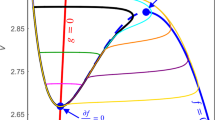Abstract
We present a model for a conditional bursting neuron consisting of five conductances: Hodgkin-Huxley type time- and voltage-dependent Na+ and K+ conductances, a calcium activated voltage-dependent K+ conductance, a calcium-inhibited time- and voltage-dependent Ca++ conductance, and a leakage Cl(− conductance. With an initial set of parameters (versionS), the model shows a hyperpolarized steady-state membrane potential at which the neuron is silent. Increasingg Na and decreasingg Cl, whereg i , is the maximal conductance for speciesi, produces bursts of action potentials (BursterN). Alternatively, an increase ing Ca produces a different bursting state (BursterC). The two bursting states differ in the periods and amplitudes of their bursting pacemaker potentials. They show different steady-stateI–V curves under simulated voltage-clamp conditions; in simulations that mimic a steady-stateI–V curve taken under experimental conditions only BursterN shows a negative slope resistance region. ModelC continues to burst in the presence of TTX, while bursting in ModelN is suppressed in TTX. Hybrid models show a smooth transition between the two states.
Similar content being viewed by others
References
Anderson WW (1980) Synaptic mechanisms generating nonspiking network oscillations in the stomatogastric ganglion of the lobster,Panulirus interrupts. Thesis, University of Oregon, Eugene
Benson JA, Adams WB (1987) The control of rhythmic neuronal firing. In: Kaczmarek LK, Levitan IB (eds) Neuromodulation — the biochemical control of neuronal excitability. Oxford University Press, Oxford, pp 100–118
Benson JA, Adams WB (1989) Ionic mechanisms of endogeneous activity in molluscan burster neurons. In: Jacklet JW (ed) Cellular and neuronal oscillators. Dekker, New York, pp 87–120
Chay TR, Keizer J (1983) Minimal model for membrane oscillations in the pancreaticβ-cell. Biophys J 42:181–189
Connor JA (1985) Neural pacemakers and rhythmicity. Annu Rev Physiol 47:17–28
DiFrancesco D, Noble D (1989) The currenti F and its contribution to cardiac pacemaking. In: Jacklet JW (ed) Cellular and neuronal oscillators. Dekker, New York, pp 31–58
Flamm RE, Harris-Warrick RM (1986) Aminergic modulation in lobster stomatogastric ganglion. II. Target neurons of dopamine, octopamine, and serotonin within the pyloric circuit. J Neurophysiol 55:866–881
Gear CW (1971) Numerical initial value problems in ordinary differential equations. Prentice-Hall, Englewood Cliffs, NJ
Getting PA (1988) Comparative analysis of invertebrate central pattern generators. In: Cohen AH, Rossignol S, Grillner S (eds) Neural control of rhythmic movements. Wiley, New York, pp 101–127
Graubard K, Ross WN (1985) Regional distribution of calcium influx into bursting neurons detected with arsenazo III. Proc Natl Acad Sci USA 82:5565–5569
Harris-Warrick RM, Flamm RE (1987) Multiple mechanisms of bursting in a conditional bursting neuron. J Neurosci 7:2113–2128
Hindmarsh AC (1974) GEAR: Ordinary differential equation solver. Lawrence Livermore Laboratory Rept. No UCID-3001, Rev 3
Hindmarsh JL, Rose RM (1984) A model of neural bursting using three coupled first order differential equations. Proc R Soc Lond B 221:87–102
Hodgkin AL, Huxley AF (1952) A quantitative discription of membrane current and its application to conduction and excitation in nerve. J Physiol 117:500–544
Hooper SL, Marder E (1987) Modulation of a central pattern generator by the peptide, proctolin. J Neurosci 7:2097–2112
Llinás RR (1988) Intrinsic electrophysiological properties of mammalian neurons: insights into central nervous system function. Science 242:1654–1664
Marder E, Eisen JS (1984) Electrically coupled pacemaker neurons respond differently to same physiological inputs and neurotransmitters. J Neurophysiol 51:1362–1374
Meyrand P, Marder E (1989) Endogeneous oscillatory properties of a striated muscle are activated by FMRFamide-like peptides. (submitted for publication)
Meyrand P, Moulins M (1986) Myogenic oscillatory activity in the pyloric rhythmic motor system of crustacea. J Comp Physiol A 158:489–503
Noble D, DiFrancesco D, Denyer J (1989) Ionic mechanisms in normal and abnormal cardiac pacemaker activity. In: Jacklet JW (ed) Cellular and neuronal oscillators. Dekker, New York, pp 59–86
Petersen OH, Findlay I (1987) Electrophysiology of the pancreas. Physiol Rev 67:1054–1116
Plant RE (1981) Bifurcation and resonance in a model for bursting nerve cells. J Math Biol 11:15–32
Plant RE, Kim M (1976) Mathematical description of a bursting pacemaker neuron by a modification of the Hodgkin-Huxley equations. Biophys J 16:227–244
Rinzel J (1987) A formal classification of bursting mechanisms in excitable systems. In: Teramoto T, Yamaguti M (eds) Mathematical topics in population biology, morphogenesis and neuroscience. Springer, Berlin Heidelberg New York, pp 267–281
Rinzel J, Baer SM (1988) Firing threshold of the Hodgkin-Huxley model for a slow current ramp: a memory effect and its dependence on fluctuations. Biophys J 53:551–556
Rinzel J, Lee YS (1987) Dissection of a model for neuronal parabolic bursting. J Math Biol 25:653–675
Robertson RM, Moulins M (1981) Firing between two spike thresholds: implications for oscillating lobster interneurons. Science 214:941–943
Rose RM, Hindmarsh JL (1989a) The assembly of currents in a thalamic neuron. I. The three dimensional model. Proc R Soc Lond B 237:267–288
Rose RM, Hindmarsh JL (1989b) The assembly of currents in a thalamic neuron. II. The stability and state diagrams. Proc R Soc Lond B 237:289–312
Rose RM, Hindmarsh JL (1989c) The assembly of currents in a thalamic neuron. III. The seven dimensional model. Proc R Soc B 237:313–334
Ross WN, Graubard K (1989) Spatially and temporally resolved calcium concentration changes in oscillating neurons of crab stomatogastric ganglion. Proc Natl Acad Sci USA 86:1679–1683
Selverston AI, Moulins M (1985) Oscillatory neural networks. Annu Rev Physiol 47:29–48
Van Renterghem C, Romey G, Lazdunski M (1988) Vasopressin modulates the spontaneous electrical activity in aortic cells (line A7r5) by acting on three different types of ionic channels. Proc Natl Acad Sci USA 85:9365–9369
Wilson WA, Wachtel H (1974) Negative resistance characteristic essential for the maintenance of slow oscillations in bursting neurons. Science 186:932–934
Author information
Authors and Affiliations
Rights and permissions
About this article
Cite this article
Epstein, I.R., Marder, E. Multiple modes of a conditional neural oscillator. Biol. Cybern. 63, 25–34 (1990). https://doi.org/10.1007/BF00202450
Received:
Accepted:
Issue Date:
DOI: https://doi.org/10.1007/BF00202450




